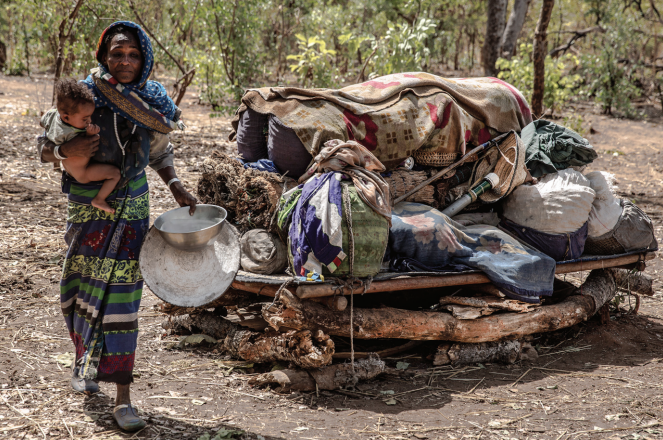Last month, the International Center for Transitional Justice (ICTJ) released I Am 100% Central African, a research report that has helped shed light on the experiences of Central African refugees living in Chad and Cameroon. This report synthesizes the research of Enrica Picco, who spent five weeks in 2017 interviewing displaced persons from the Central African Republic (CAR) and representatives of 20 national and international organizations working in the region. For many of those interviewed for this report, this was their first opportunity to tell their story.
In March 2013, a coalition of mainly Muslim armed groups known as Seleka, carried out a coup, overthrowing the Central African government and taking over the capital, Bangui. In the process, Seleka rebels also carried out violent attacks on civilian populations in and around Bangui. In response, mainly Christian militias, which came to be known as ‘anti-balaka’ formed and began attacking Seleka bases and targeting Muslim communities with violence, indiscriminate of their association with Seleka rebels. A cycle of retaliation between Seleka and anti-balaka groups caused thousands to flee Bangui and the surrounding areas in search of safety, many of them fleeing the country altogether.

Muslim women who fled from Bangui in February 2014, during the peak of the inter-communal violence, were forced to lie down with their families in a truck full of displaced people. Ndele (Bamingui-Bangoran), 2015. (Juan Carlos Tomasi)
Since then, Seleka and anti-balaka groups have splintered and spread out throughout much of the country, targeting local populations with violence and exploitation largely along religious, ethnic, and socioeconomic lines. Following a period of relative stability in 2016, violence spiked in early 2017, especially in the eastern part of CAR, where communities far from the western capital of Bangui had previously been spared much of the violence associated with Seleka and anti-balaka groups. This new wave of violence caused thousands more Central Africans to flee their homes. Today, more than one in four (about a million) Central Africans are displaced, 480,000 of whom are refugees in neighboring countries.
Despite the fact that Central African refugees are among those most impacted by the conflict, they are often overlooked and excluded from conversations about solutions. This kind of exclusion from the reconciliation and rebuilding process can often lead to ineffective solutions and continued cycles of violence. That is why reports like this one, and the in-depth research that make it possible are so important.
We highly recommend reading the report (or at least the executive summary) for yourself, but here are some of the key highlights we picked up while reading it.
Discrimination and lack of inclusion is a crucial underlying issue facing Central African refugees.
For many of the refugees interviewed, this was the first time they had the opportunity to tell their story and be listened to. Many spoke of the discrimination and exclusion they faced as Muslim Central Africans. Before leaving CAR, these refugees were often considered not truly Central African due to their place of origin, ethnicity, or religion. One refugee stated simply, ““In CAR, if you are a Muslim, you are a foreigner.” These types of divisions among Central African communities were a major contributing factor to the current conflict and continue to be the biggest hurdle to overcome in establishing peace.

Nomadic groups such as the Peuhls pass through the north of CAR, camping in the bush, where they can install their tents close to their cattle. Ndele (Bamingui-Bangoran), 2015. (Juan Carlos Tomasi)
Central African refugees intend to return to CAR, but not yet.
Many of those interviewed referenced an intention to return to their homes in CAR, but also noted that they would not return for some time. Continued violence and an overall lack of security in many areas of CAR is preventing many from returning. For the most part, Central African refugees also know that they have little to return to, now that many of their homes have been destroyed and since economic opportunities in CAR are extremely limited today, as a result of instability.
The most vulnerable continue to be the most severely impacted by conflict and displacement.
Several refugees who were interviewed discussed the higher impact that the conflict and displacement has had on especially vulnerable members of their communities, including women, young people, and Peuhl individuals, an ethnic minority in CAR who often live in nomadic cattle herding communities. Women interviewed openly spoke about rape and sexual exploitation within refugee camps and about the deterioration of social norms as a result of displacement.
Refugees know that reconciliation will not be easy and that everyone must be involved.
When asked about their thoughts on reconciliation, those interviewed primarily agreed that the process would not be easy once they were able to return to CAR. Refugees stressed the importance of both top level messages of inclusivity from national leaders as well as the involvement of local leaders and institutions such as churches and local chiefs to facilitate reconciliation among affected communities.
Finally, Central Africans impacted by the conflict in CAR are incredibly resilient.
Despite years of conflict, immeasurable loss, and the trauma of violence and displacement Central Africans continue to look ahead toward a better future. The stories shared in ICTJ’s report only reinforce what we at Invisible Children have seen time and again. Communities, families, and individuals throughout central Africa are working tirelessly toward solutions so that, one day, their children and all those who come after them have the opportunity to live in peace and to thrive.

Mbororo refugee women prepare communal land for the next planting season in Gbiti. October 2009. (UNHCR / F. Noy)
We couldn’t be more grateful to be working alongside the brave central African leaders who are creating a brighter and safer future. Their hope and strength inspire us every day to continue our work to end violence and exploitation among our world’s most vulnerable communities.
JOIN US. DONATE TO PROGRAMS THAT ARE CREATING A SAFER FUTURE FOR THOUSANDS.
Think people should hear about this?